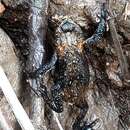Brief Summary
(
Inglês
)
fornecido por IABIN
DiagnosisA medium sized species belonging to the M. tumifrons group and diagnosed by the following combination of characters: (1) snout-vent length 24.0-26.0mm in males, 27.7-29.5mm in females; (2) head broader than long, with a prominent, rounded protuberance above snout, extending between the eyes to a point near the middle of the length of the upper eyelid; (3) skin on dorsal and lateral surfaces of body largely covered by spinulose warts; (4) foot without tumefaction on metatarsus; (5) ground color of dorsum, flanks, and venter dark brown; (6) three small pale yellow blotches in the gular region; (7) on the chest, just at the insertion of the arms, belly, ventral surfaces of forearms and thighs, and palmar and plantar surfaces pale yellow; (8) dorsal surfaces of legs dark brown; (9) small pale yellow spot above cloacal opening and at tibiotarsal articulation.
- licença
- cc-by-nc-sa-3.0
- direitos autorais
- Museo Nacional de Historia Natural
- autor
- Esteban O. Lavilla
- editor
- Diego Arrieta
Distribution
(
Inglês
)
fornecido por IABIN
North of Rio Grande do Sul State and South of Santa Catarina State, Brazil.
- licença
- cc-by-nc-sa-3.0
- direitos autorais
- Museo Nacional de Historia Natural
- autor
- Esteban O. Lavilla
- editor
- Diego Arrieta
Diagnostic Description
(
Inglês
)
fornecido por IABIN
Description of holotype General aspect robust, bufonoid. Head broader than long; head width nearly one third of snout-vent length; head lacking cranial crests; snout short, slightly projecting beyond the mouth, rounded in dorsal view and vertical in lateral view; a prominent, rounded protuberance above snout, extending between eyes to a point near mid length of upper eyelid; in lateral view, snout protuberance is raised above the level of upper eyelid; a conspicuous longitudinal sulcus bisects snout protuberance; canthus rostralis rounded due to snout protuberance; loreal region slightly concave, vertical; nostrils small, at tip of snout, directed anteriorly; internarinal distance slightly less than upper eyelid width and approximately 80% of interorbital distance; upper eyelid width approximately 90% of interorbital distance; eye diameter greater than internarinal distance and eye to nostril distance, equal to upper eyelid width, and smaller than interorbital distance; tympanum concealed; vocal slits present; tongue rounded, much longer than wide, with posterior margin free; choanae small, rounded, largely separated. Arms slender, lacking ulnar folds; axillary membrane absent. Hand with fingers short; length of fingers from shortest to largest, IVariation The dorsal color pattern is invariable; ventral pattern varies little, mainly in the shape and size of pale yellow blotches and spots. Measurements of paratypes males (n=6) and females (n=4), range, (mean ±standard deviation): snout vent length 24.0-26.0 (24.8±3.21) 27.7-29.5 (28.6±3.36); head length 6.1-7.0 (6.6±1.89) 7.9-8.3 (8.1±2.09); head width 7.9-8.8 (8.3±2.11) 8.4-9.3 (8.9±2.18); internarinal distance 1.9-2.3 (2.0±0.68) 1.8-2.2 (2.0±0.72); eye to nostril distance 2.1-2.3 (2.2±0.78) 2.0-2.4 (2.3±0.82); eye diameter 2.4-2.7 (2.5±0.93) 2.5-2.7 (2.6±0.96); upper eyelid width 2.2-2.6 (2.3±0.85) 2.4-2.7 (2.6±0.95); interorbital distance 2.6-3.2 (3.0-1.11) 2.9-3.3 (3.2±1.16); thigh length 9.6-10.6 (10.0±2.30) 9.7-11.2 (10.4±2.34); tibia length 8.6-9.8 (9.4±2.24) 9.5-10.9 (10.1±2.32); foot length 14.7-16.5 (15.3±2.73) 15.6-17.2 (16.4±2.80).
- licença
- cc-by-nc-sa-3.0
- direitos autorais
- Museo Nacional de Historia Natural
- autor
- Esteban O. Lavilla
- editor
- Diego Arrieta
Conservation Status
(
Inglês
)
fornecido por IABIN
DD. Data Deficient. Populations of M. simplex are threatened because of habitat destruction for large scale alien plant cultivation, urbanization pressures, and the use of fire in grassland management.
- licença
- cc-by-nc-sa-3.0
- direitos autorais
- Museo Nacional de Historia Natural
- autor
- Esteban O. Lavilla
- editor
- Diego Arrieta

